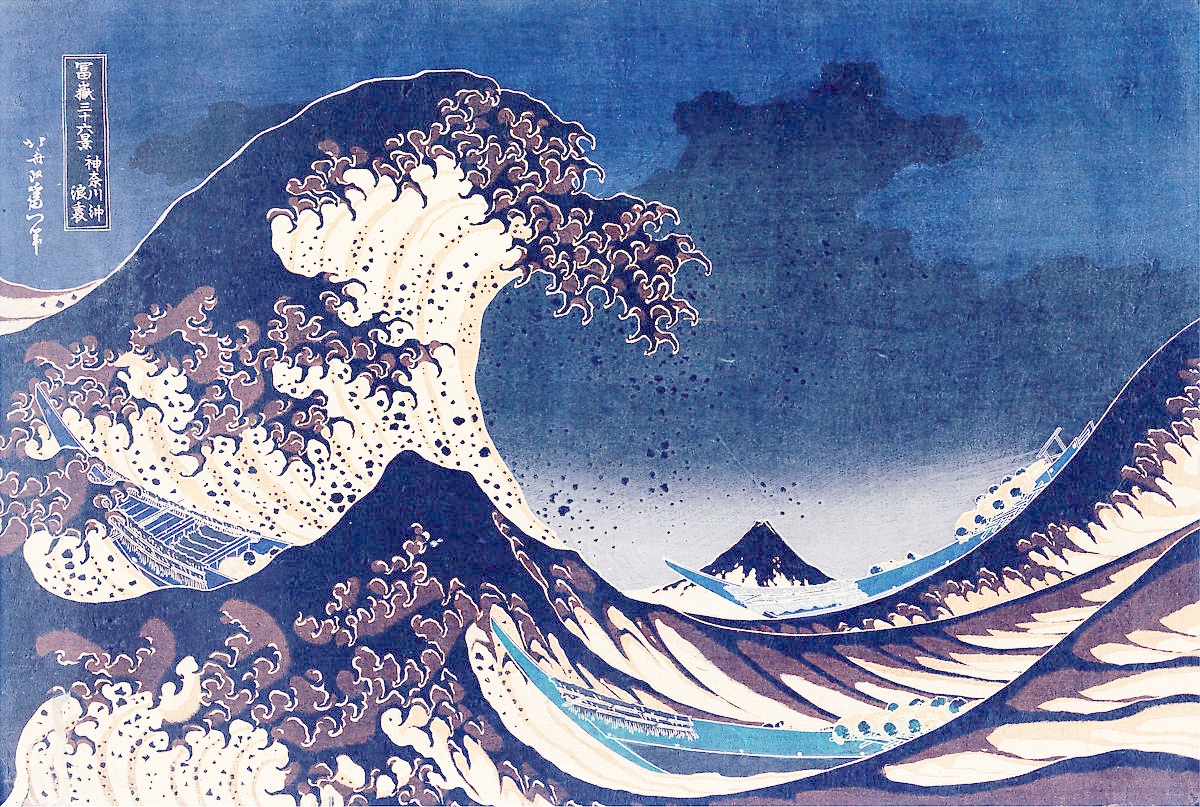For two plus decades, there has been a severe drought in the materials available to beginners for mastering Japanese intuitively, so we created a New Type of Textbook for learning and mastering the Japanese language. Here we describe the unique features of our program and sequence, which insights provided the opportunity to arrive at these new techniques, and what our learners think.

https://www.thisiscolossal.com/2020/12/jumpei-mitsui-great-wave-lego/
How the Japanese Complete assumptions and assumptions from other programs and textbooks differ
- Teenage and Adult Language Learners already know tons of nouns in their mother tongue, so the focus must be on elements that are unique to the internal linguistic structure of Japanese, namely grammar situation and verbs.
- Japanese is fundamentally made of nouns and verbs and while English is a noun-oriented language, Japanese is a verb-oriented language: rather than static, unchanging blocks with properties, every scene and situation is fresh and ongoing with dynamism. [From 1, with explanation below] “Life is verbings” instead of “Life is a collection of nouns.”
- Japanese Grammatical Particles are what give weight to nouns — the who, what, when, where, why, and how are all explained only through help of grammatical particles, so particles ought be introduced as units inseparable from nouns, and ought be introduced thoroughly (covering all possible meanings, not just one or two select ones leading to minefields and surprises later).
- Of the 20 most common glyphs in Japanese, over half are grammatical particles, so rather than ignore the statistics we embrace them and teach in our innovative “Particles First” style.
Unique Features and Notable Differences
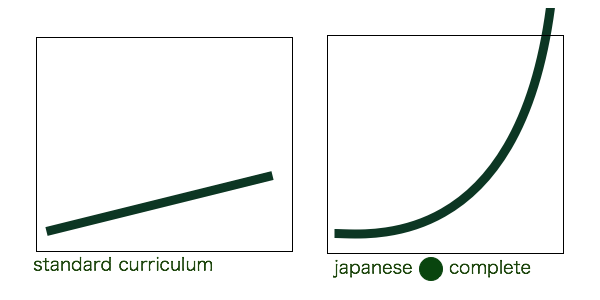
Here’s a list of some of the notable differences of Japanese Complete, when compared with other programs, textbooks, curricula, and courses for learning Japanese:
- Our Innovative “Particles First Approach” for Hyperdifferentiation of Particles
- K漢nj字 in 英ngl語sh C文nt脈xt [Kanji in English Context]
- Quizzes where you cannot be dishonest about your knowledge of Kanji, verbs, and particles,
- A curriculum based on the Frequency Analysis provided by the Balanced Corpus of Contemporary Written Japanese (2011) so what you learn is immediately apparent in native-media.
- Thorough Explanations of the Grammar surrounding each particle and its numerous uses/modes, as well as our innovation: Bunsetsu Jars
- Kanji etymology, meanings, mnemonics, writing practice
- Relegating nouns to later on (research shows that while grammar situation with particles and verbs are more nuanced and require more practice, nouns are easily acquired by learners of every skill level)
- Narrated pages and our Audio Reading Tutor
- Japanese Student Language with English Nouns and Japanese Grammar hybrid for rapid comprehension and assimilation.
- Storytime in 2.5 languages: useful dialogues with depth-levels of translation.
- Pitch Contour and Pitch Accent via our Social Language Learning platform called Misofluent
- Conclusion: A new Type of Textbook and Learning Platform.
We create a new format for language learning that incorporates Study, Immersion, and Generation to accelerate the acquisition process for Japanese as a second (or third) language, by focusing on the trickiest and most nuanced features of the Japanese language first.
Long-term Recall
We are aimed at long-term recall, and our users agree that our approach gives them long-term recall for grammar particles, kanji meanings, and verbs. This means that instead of forgetting what you just learned, it sticks with you for months and months down the road because of the cohesive order in which new lessons are introduced, and the colorful imaginative scenes we provide with kanji.
We asked some of our learners about their experience with long-term recall. This one image captures the group consensus. (At the time of this writing we are still awaiting responses from some of our learners.)
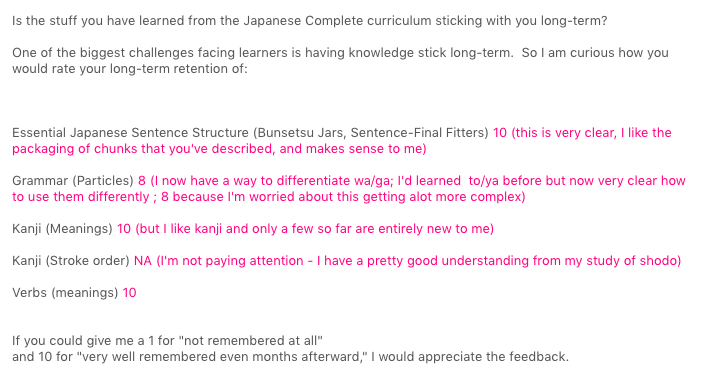
Abbreviated Results: Sentence Structure 10, Grammar 8, Kanji 10, Verbs 10.
Overall, our learners agree, we have created a novel method for establishing the most solid of linguistic foundations, yielding swift understanding, identification of elements in the wild as rapidly as possible, and the much-sought-after unshakeable long-term recall.
Relegating Nouns to the Periphery
Knowing Japanese unlocks access to a deeper aspect of Japanese culture and thought. While most programs attempt to teach nouns to start, Japanese Complete pulls the tail of the language dragon in a different direction, focusing on rapid recognition of the Hiragana, and an intuitive understanding of grammar (particles, bunsetsu jars) and verbs (doings, happenings).
Because Nouns are easiest to acquire and their acquisition is largely automatic with the aid of a dictionary, we must teach what is unteachable through self-immersion, dictionary-based replacement and analysis, and what is otherwise unlearnable when trying to soak up the language naturally without special emphasis on the unknowns.
We must impart an intuition for Japanese because the linguistic structure leans on a different set of internal assumptions, namely that everything is verbing, grammatical functional words called particles indicate who/what/when/where-ness, and we can partially mask verbs with kanji ideograms.
How
Conversations including our qualified language teachers with Japanese Language Professor Hill had lead to several breakthroughs in teaching Japanese. We summarize the salient differences in our classification of Japanese words on our Reverse Engineer Some Japanese page.
Essentially, we got brilliant language experts together, talked theory, and disassembled the Japanese language into its most fundamental parts for elegance, flexibility, and swiftness of understanding, allthewhile ensuring the preservation of integrity, possibility, and clarity.
In brief, we work backwards from the desired result: to be able to understand, comprehend, anticipate, and communicate. We derived a curriculum from the most-frequent-glyphs, advances in Kanji education (imaginative memory aides as well as our masking concept), and leveraging online quizzes and narration with social language generation on Misofluent.
Work Backwards from the Desired Result
In our case, we work backwards from the desired result of Fluency and the Five Factors for Fluency. We identify:
- Grammar Situation,
- Pitch Contour / Pitch Accent,
- Mouth Shape/ Readability and Gesticulations,
- Language Anticipation and,
- Vocabulary.
Hiragana and the Iroha
We offer for free our Hiragana Listening Page — identify the correct Hiragana.
Click on each mora to hear it spoken by one of several native speakers.

For subscribers, our curriculum uniquely uses the classical Iroha poem that is a pangram of the Hiragana (minus vocalized and plosive modulations)
Convenient Listening
We narrate the pages to our book so you can listen along as you master Japanese. Our curriculum provides audio for the textbook pages and for the dialogues. Lessons and narration recordings are added as we continue to develop the curriculum.
Our Course teaches you Kanji ideograms for the long-term.
Kanji ideograms are fascinating and, as any student of Japanese will tell you, are hard to recall long-term without consistent rote memorization practice or some better technique. The book Remembering the Kanji introduces a technique devised by Heisig to combine kanji components (what we call subkanji) with thematic story-like elements to draw and limn an imaginative scene, landscape, or situation to aide in the recall of kanji meanings, stroke orders, and even readings. We have adapted the techniques from Heisig to comply with the listing of the most frequent kanji in the wild and we provide mnemonics for every kanji we teach, not just the first few as Heisig does.
We Teach Kanji Gradually
- Kanji elements (subkanji) and their meanings
- Kanji etymological origins, how the drawing came to be
- Kanji meaning words to associate with the kanji
- Mnemonic scene for linking and connecting the meaning-words with the ideogram
- Kanji arranged by Frequency of occurrence in the Wild
As the course progresses, we teach readings and multi-kanji nouns (what we call Kanji Clusters).
We invented a new way to teach Kanji meanings and accelerate kanji recognition
Kanji Masking and Kanji in English Context.
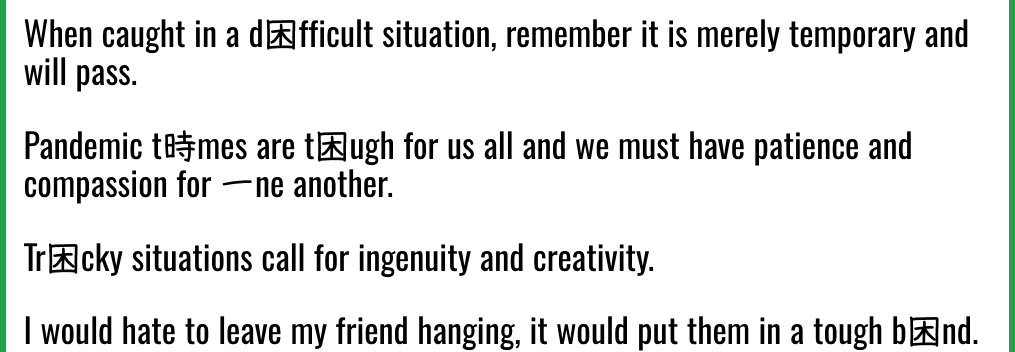
Kanji ideograms are used to convey associated concepts, and are used uniquely in Japanese to mask parts of Japanese writing, quite similar to the above and below images for English sentences with Kanji in English Context.
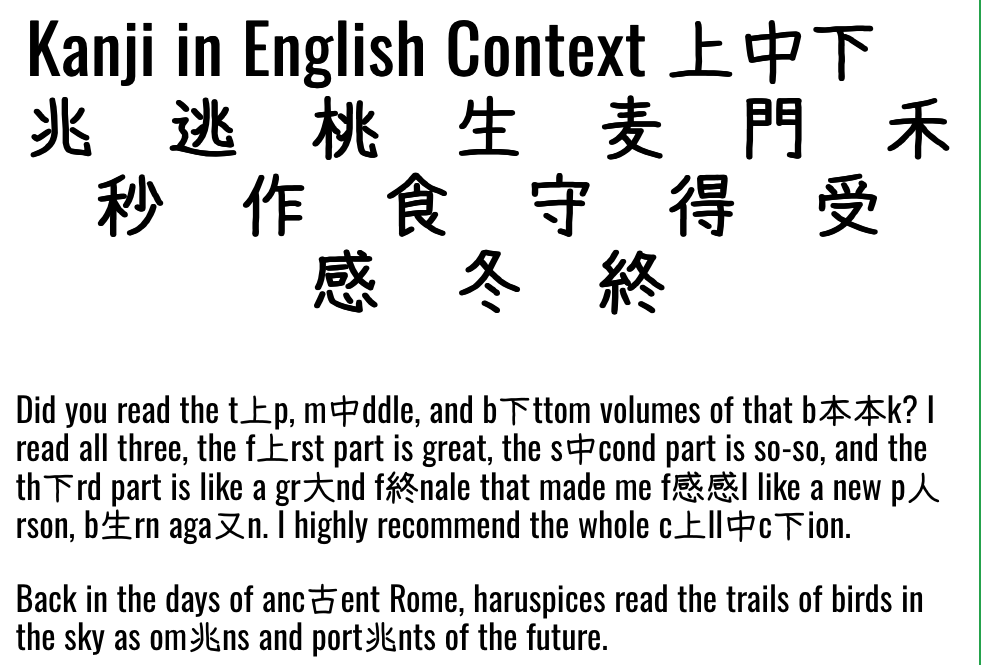
We Teach New Grammar Formulae Gradually and Thoroughly
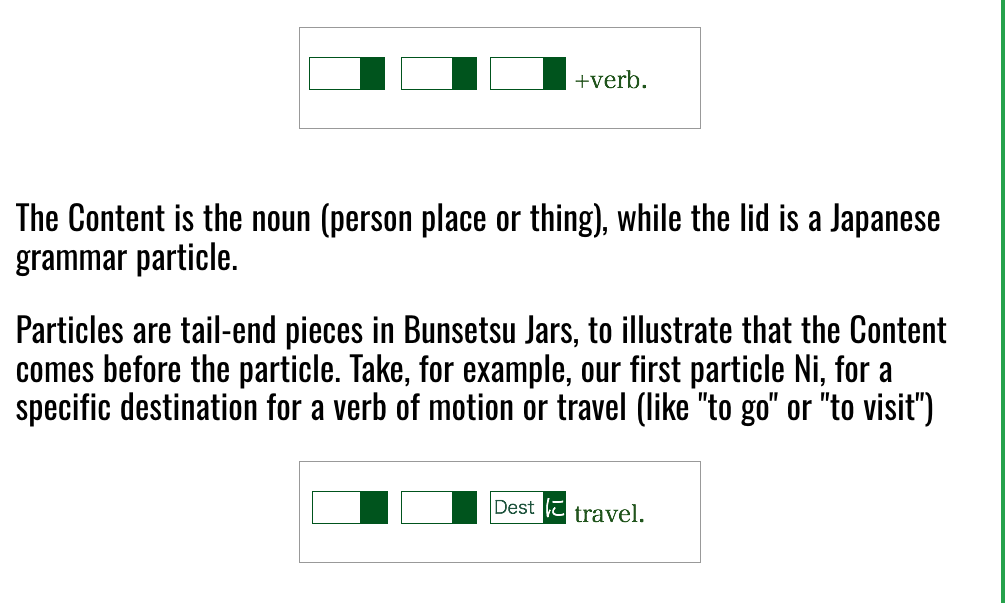

- We introduce the concept of Bunsetsu Jar
- We teach grammatical particles by their frequency of occurrence in the wild (with some care taken to aesthetically order them for maximum learning effectiveness)
- We teach all the meanings of a particle when introducing them for completeness and no-surprises-down-the-line-technology ™. We focus on one usage or mode at a time, to get one’s mind familiar with the flexibility.
- We teach using simply Verbs and Nouns, getting to the essence of Japanese sentence structure quickly and thoroughly, while retaining the flexibility and creative potential. Fewer rules with greater purview, as you can experience on the Reverse Engineer page.
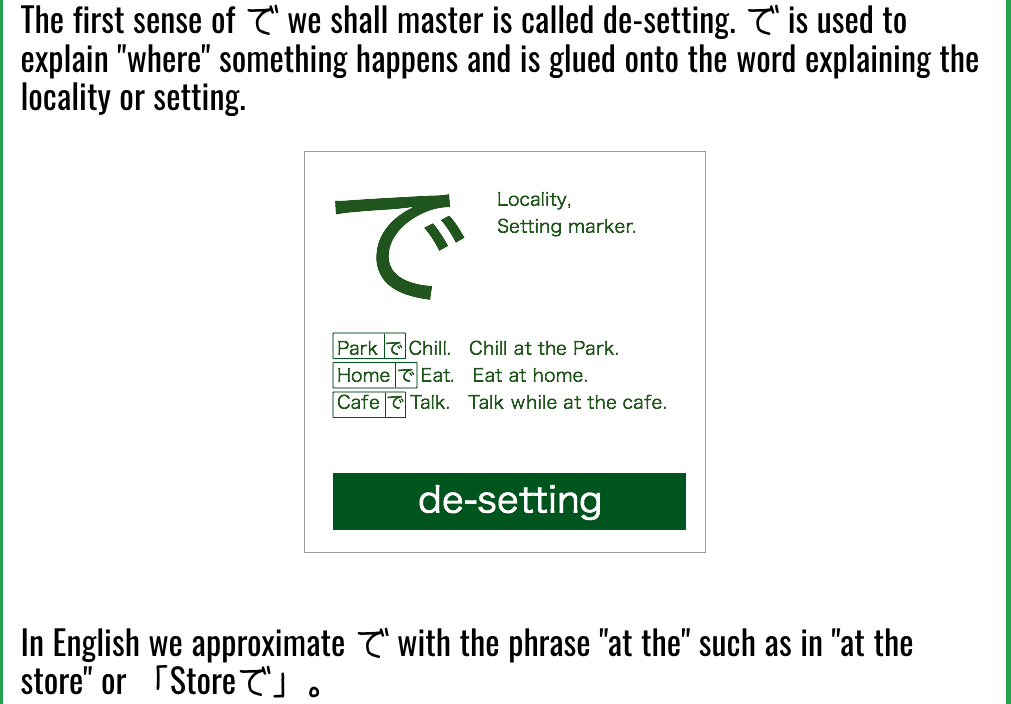
We provide Social Language Learning with Teacher Correctness
Misofluent is our newest addition to the Japanese Complete Experience that enables learners to use mad-libs-like formula cards to generate JSL (Japanese Student Language) and a qualified master of Japanese provides audio and pitch-contour imagery.
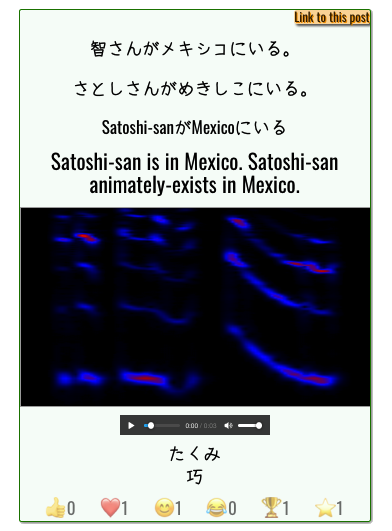
Users can create novel compositions to practice generating Japanese with very low friction: all you need is some grammar understanding and English nouns that a teacher will convert for you.
Why Choose Japanese Complete?
- Curriculum Arranged by Frequency Analysis
- Our course is heavily backed by research.
- The course is thorough, engaging, and will stick with you long-term, which is actually useful.
- Quizzes at the end of each chapter ensure your knowledge is strong, and the daily cumulative quiz combines everything you’ve seen in an easy-to-practice format.
“I want to learn Japanese for anime”
-People who grew up watching Death Note and Dragonball Z.
I want to learn Japanese for movies and shows
-People catching Terrace House on Netflix
Anime lovers rejoice, show lovers rejoice! Our curriculum is based on a corpus that is a collection of Japanese in-the-wild from many varied media, so the grammar, particles, and kanji you learn in Japanese Complete will be immediately apparent in native Japanese films and shows — we teach the grammar and kanji that occur most often, first (with some aesthetic ordering for cohesion in the curriculum).
This means that even after just a few lessons, you’ll be identifying kanji and particles in native Japanese shows and films.
In Support of Dynamism
Here is a research excerpt in support of the “life is verbings” versus “life is a collection of nouns” when comparing Japanese internal language structure to English.

